2022 AIA Wisconsin Design Award Winners
This year, twelve projects have been recognized for excellence in architectural design by the 2022 Design Awards program of AIA Wisconsin, the state society of The American Institute of Architects (AIA).
All projects were designed by AIA Wisconsin architect members. Out of 60 total entries from architects across the state of Wisconsin, four projects were awarded the Honor Award for overall excellence, and eight projects received Merit Awards for distinction in a focused area. All but one winning project is located in the state itself.
A nationally distinguished jury from outside of Wisconsin selected the award-winning projects. Members of the 2022 Design Awards jury were Dr. Bruce Race, FAIA, Kate Schwennsen, FAIA, and Mark Peters, AIA.
AIA Wisconsin has been promoting, supporting, and advocating on behalf of architects in the state of Wisconsin since 1911. The member organization focuses on providing continuing education to architects and designing a better built environment for the future. Each Design Award submission included AIA’s Framework for Design Excellence, which asks questions regarding how the project considered social and environmental issues in its design. Each of this year’s projects were measured not just on aesthetic components, but how the building interacts with people and the natural environment.
In celebration of the 2022 winners, AIA Wisconsin will be hosting their second annual Design Awards Gala in Milwaukee on Friday, September 16, 2022. Purchase tickets here. Ticket sales end at midnight CT on September 8, 2022. The gala will also be a fundraiser for the Wisconsin Architects Foundation’s ‘Dream Spaces’ campaign to support the diversification of Wisconsin architects by increasing accessibility to architecture school to underrepresented students. To donate to the scholarship campaign, please visit dreamspaces.org.
HONOR AWARDS
The highest distinction in Wisconsin Architectural Awards. (Listed in no particular order.)
“We saw that Midwestern attention to craft, editing to an essence, which I really appreciated. The quality of these projects was quite high.” – Kate Schwennsen, FAIA
Forest Edge Elementary School
(Fitchburg, WI) – Bray Architects
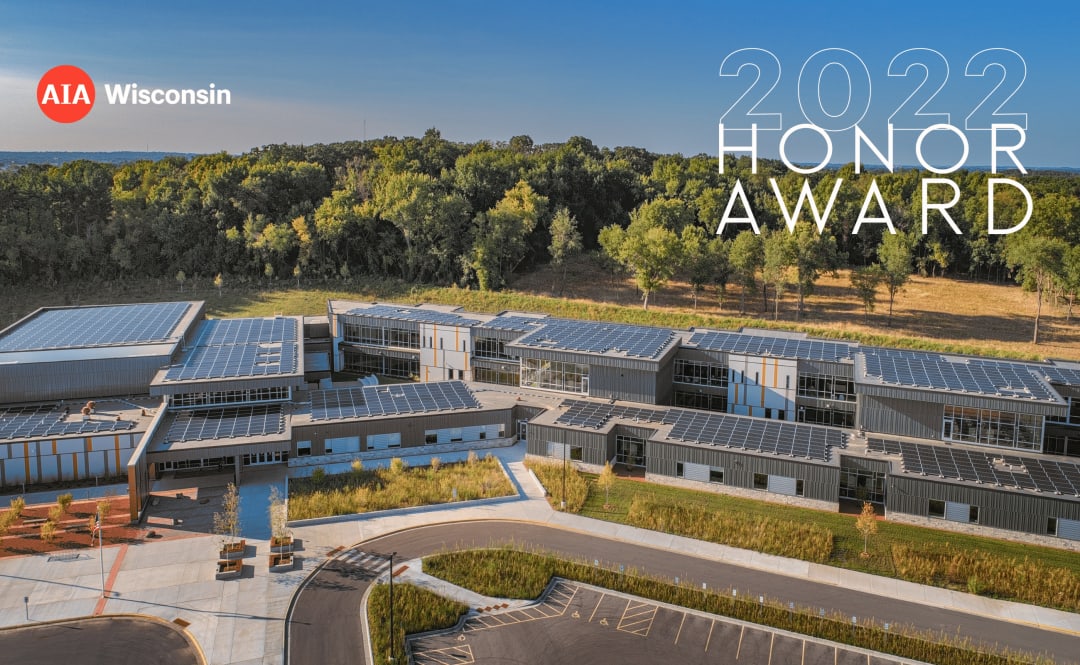
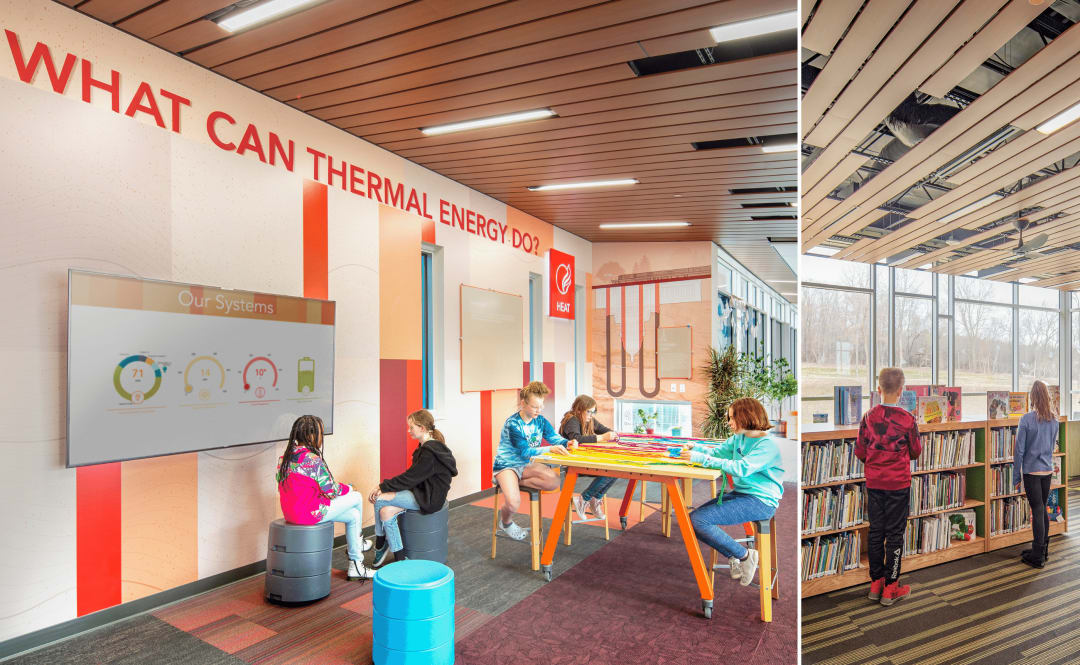
Design Architects: Stephen Kuhnen, AIA, Principal; Chris Eger, AIA, LEED® AP BD+C, Project Leader and Architect; Maria Welch, AIA, NCARB, Architect
Architecture Firm: Bray Architects
Owner: Oregon School District
General Contractor: J.H. Findorff & Son, Inc.
Project Description: The new Forest Edge Elementary School in Fitchburg, Wisconsin, is a hub of innovation and 21st-century learning practices for young students, and a regional and national pacesetter in sustainable design. The school is a verified net-zero energy building, making it the first of its kind in Wisconsin and the largest educational building to reach that milestone in the United States. In partnership with the design team, the district created an innovative building with flexible learning spaces, ample daylight, and state-of-the-art sustainable infrastructure. The result is a building that not only contributes energy back to the grid but also leverages its sustainable features as teaching tools through interactive stations that highlight the unique features of the school.
Spring Harbor House
(Madison, WI) – Johnsen Schmaling Architects
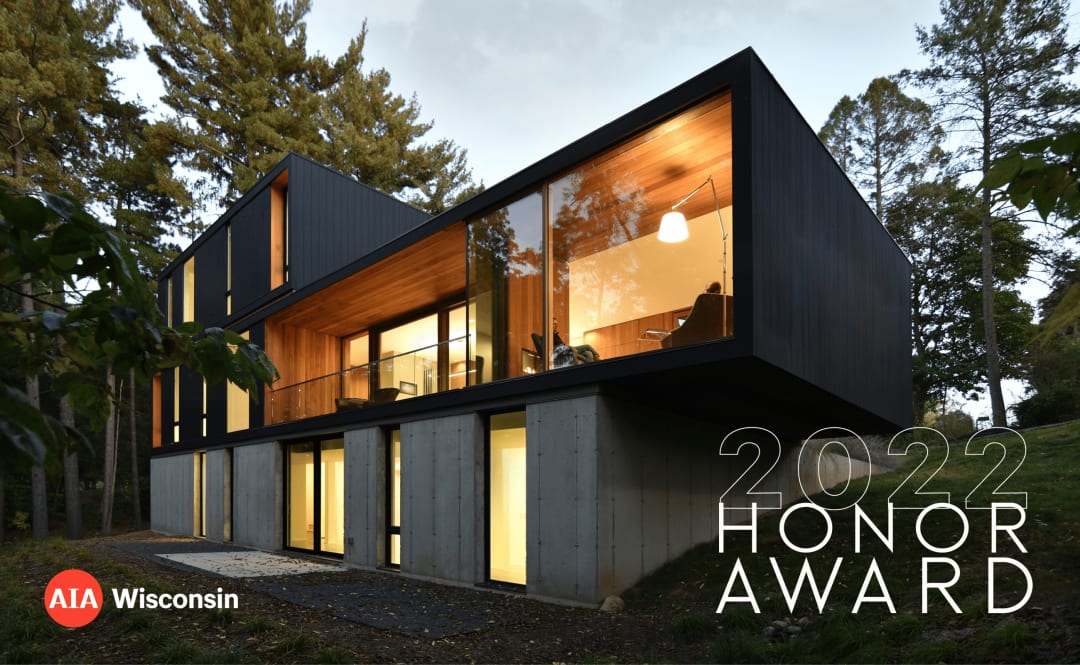
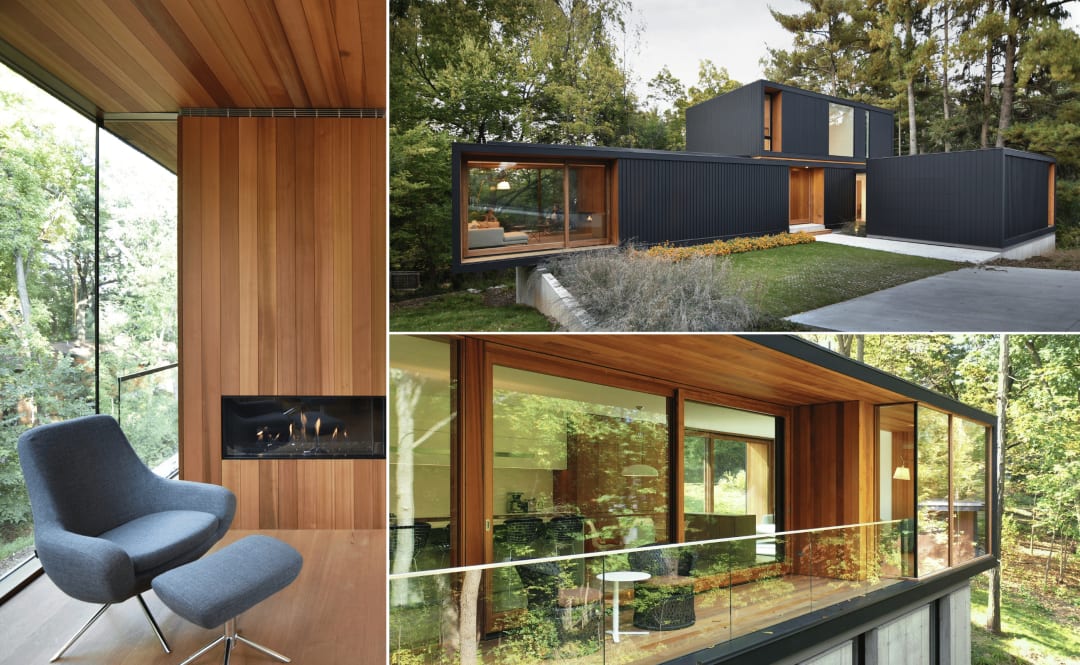
Design Architects: Brian Johnsen, AIA & Sebastian Schmaling, AIA, LEED AP
Architecture Firm: Johnsen Schmaling Architects
Owner: Private Residence
General Contractor: Aldo Partners, LLC
Project Description: Spring Harbor House is a single-family home on a formerly ignored, steeply sloped lot in Madison’s Spring Harbor neighborhood. Composed as an ensemble of three analogous volumes sitting on a concrete podium, the building is an exercise in unapologetic simplicity and formal restraint, quietly echoing and reinterpreting the compact scale, discreet massing, and genuine materiality of the neighborhood’s modest mid-century homes. The project was conceived as “house for life,” an energetically high-performing and programmatically adaptable structure that can serve its purpose not only in the present but for several generations. With insulation values that exceed code requirements by roughly 40%, and 100% stormwater runoff managed on-site, the home is environmentally resilient, aware of the often-changing Midwest weather patterns and natural Spring Harbor and Yahara watersheds.
Kornberg Center
(Fitchburg, WI) – RAMLOW/STEIN Architecture + Interiors, SmithGroup
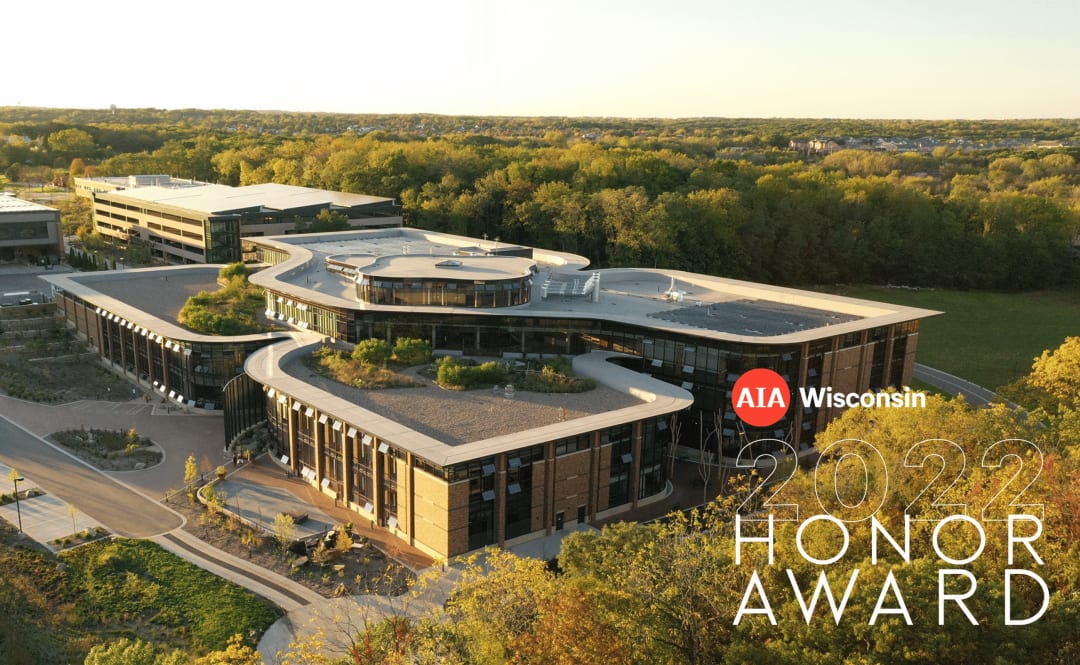
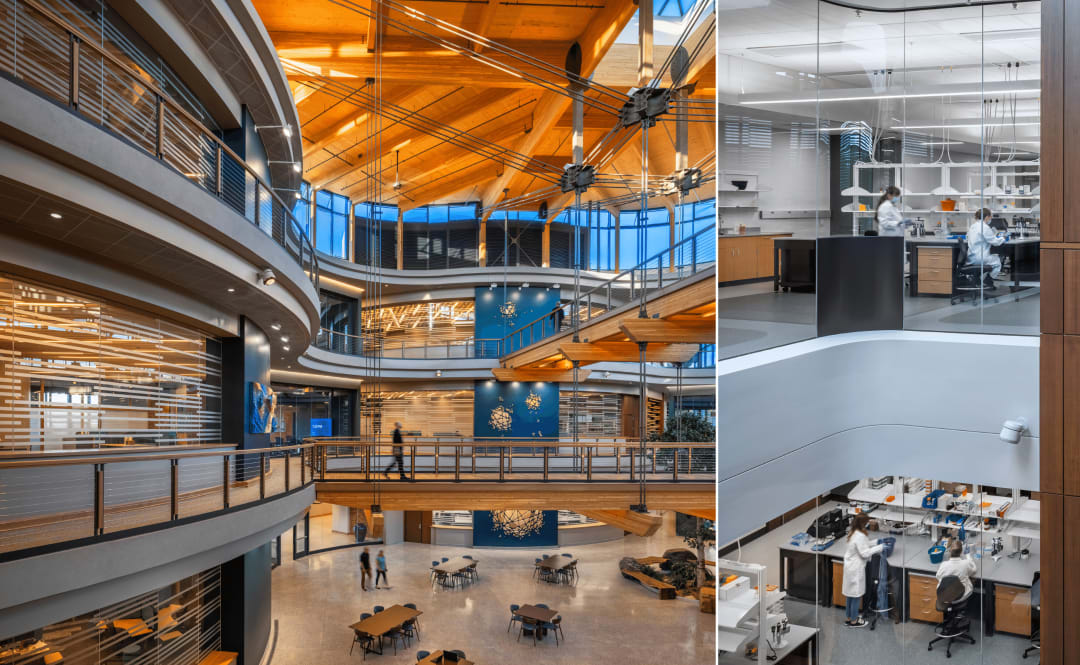
Design Architect: Nat Stein, AIA, LEED AP, NCARB
Architecture Firm: RAMLOW/STEIN Architecture + Interiors, SmithGroup
Owner: Promega Corporation
General Contractor: Kraemer Brothers
Project Description: Named for Nobel Prize-winning biochemist Arthur Kornberg, the Kornberg Center will support product and technology development in life science research, cellular and molecular biology, genetic identity, clinical diagnostic and scientific applications and training for the Promega Corporation. Designed to reduce energy use by 65% relative to comparable facilities, the use of heavy timber construction, double skin façade, mass hydronic heating and cooling, energy recovery, natural ventilation, water, and solar photovoltaics ultimately drive the form of the building. These elements are woven into to the architectural language influencing components like elevation rhythm, floor to floor heights, and floor and ceiling materials. The landscape surrounding Kornberg was also restored to a state that is compatible with its historic conditions by restoration of native prairie plantings, removal of invasive species, and drainage patterns, while Dark Sky lighting protocols were put in place with lighting fixture selections and scheduling.
Rural Ortho Clinic
(Cedarburg, WI) – Johnsen Schmaling Architects
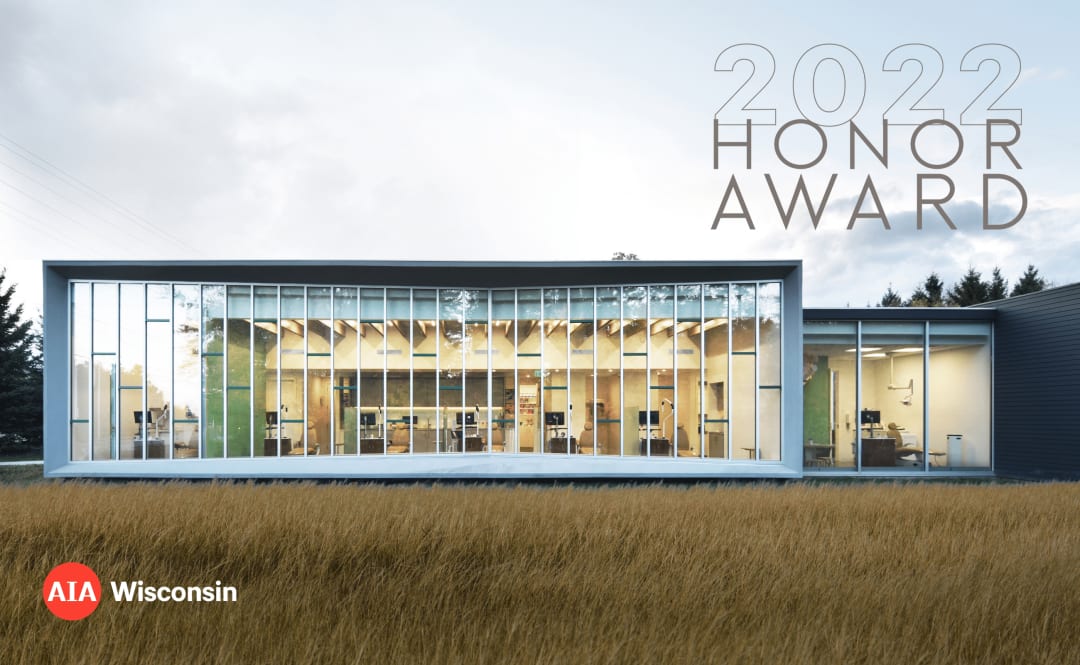
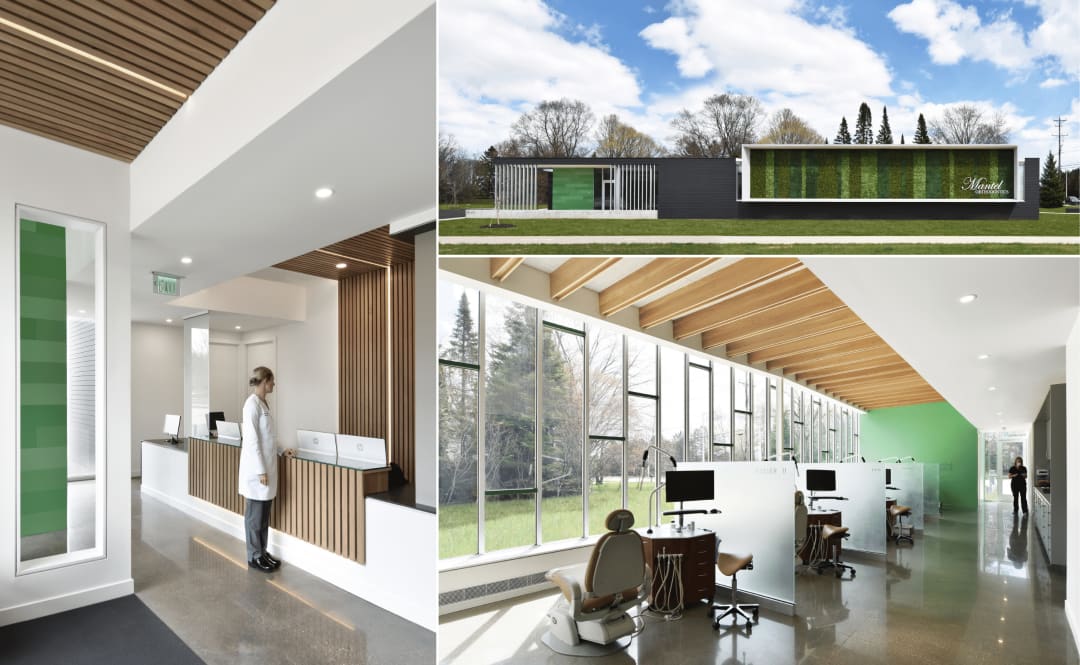
Design Architect: Brian Johnsen, AIA, & Sebastian Schmaling, AIA, LEED AP
Architecture Firm: Johnsen Schmaling Architects
Owner: Dr. Alison Mantel, DDS
General Contractor: Peridot Construction Management, LLC
Project Description: Located at the outskirts of Cedarburg, a rural town 30 miles north of Milwaukee, this small orthodontics clinic revisits the exhausted typology of conventional medical offices and their introvert, fluorescent-lit ambience. The project’s success relies on an architecture that echoes its pastoral setting while avoiding bucolic nostalgia – a crisp, precisely detailed building conveying the ethos of the orthodontist’s own professional work: uncompromising purity, flawless efficiency, and rigorous precision. Solar studies took into consideration sun angles and the shading of the eastern tree line to maximize natural light and views into the natural landscape while avoiding excessive heat gain as well as visual glare during morning appointments. Stormwater from the building and the site is directed toward a long, extensively vegetated bioswale that runs parallel to the eastern edge of the property and visually merges with the adjacent prairie meadow.
MERIT AWARDS
Awarded for a particular focus the project excelled at. (Listed in no particular order.)
“You should be quite proud of what’s happening in Wisconsin in terms of the work.” – Dr. Bruce Race, FAIA
Curtain House
(Milwaukee, WI) – Johnsen Schmaling Architects
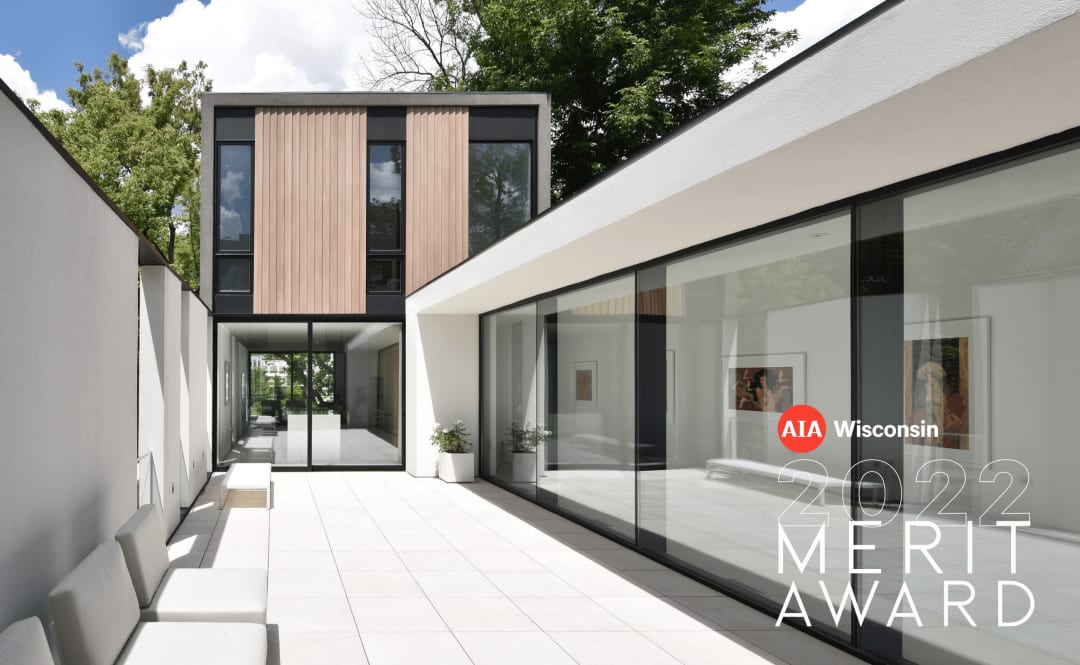
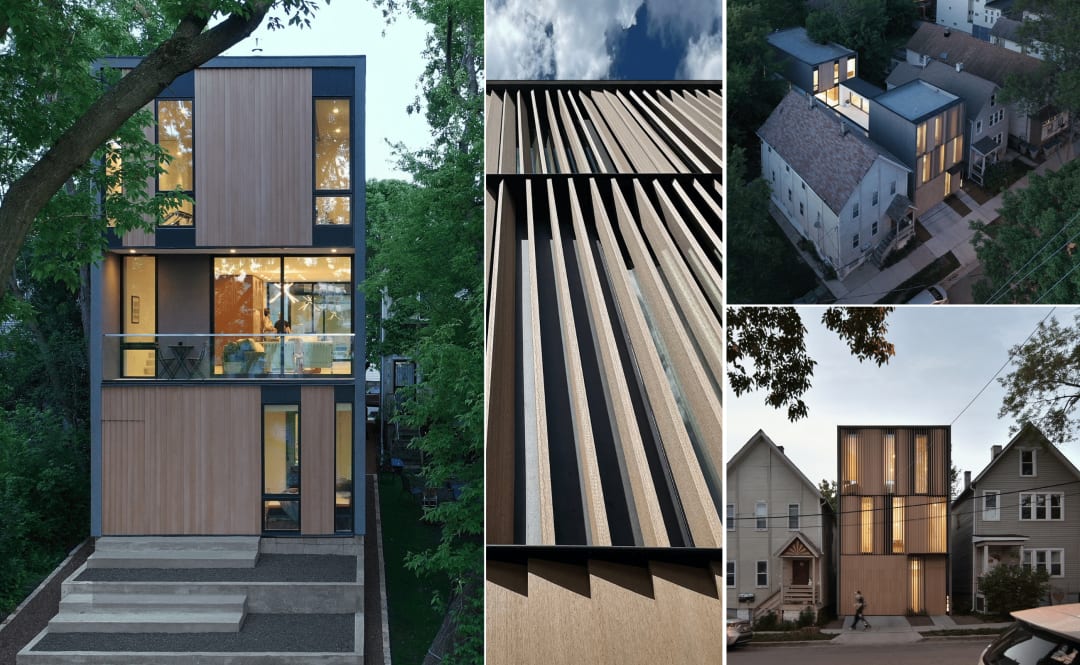
Received Merit Award for “Wonderful residential environment in a tight infill site”
Design Architect: Brian Johnsen, AIA, & Sebastian Schmaling, AIA, LEED AP
Architecture Firm: Johnsen Schmaling Architects
Owner: Private Residence
Project Description: The Curtain House is a private residence on a long-vacant, narrow parcel embedded in Milwaukee’s Lower East Side. The client, a lifelong urban dweller looking for a buildable lot in the central city to build his first home, acquired the 24’-wide infill property directly from the Milwaukee Department of City Development, which had taken ownership of it two decades earlier after condemning and razing an abandoned house there. The building’s street façade was conceived as a playful abstraction of the ubiquitous drapes that cover virtually all windows in urban residences. Those domestic curtains, while inherently antithetical to the concept of glazed transparency, serve a necessary purpose: they provide privacy from the public realm and modulate the amount of light entering the building. Interior finishes are dominated by whites and greys that augment the natural light filtering into the spaces.
Springs Window Fashions
(Middleton, WI) – OPN Architects
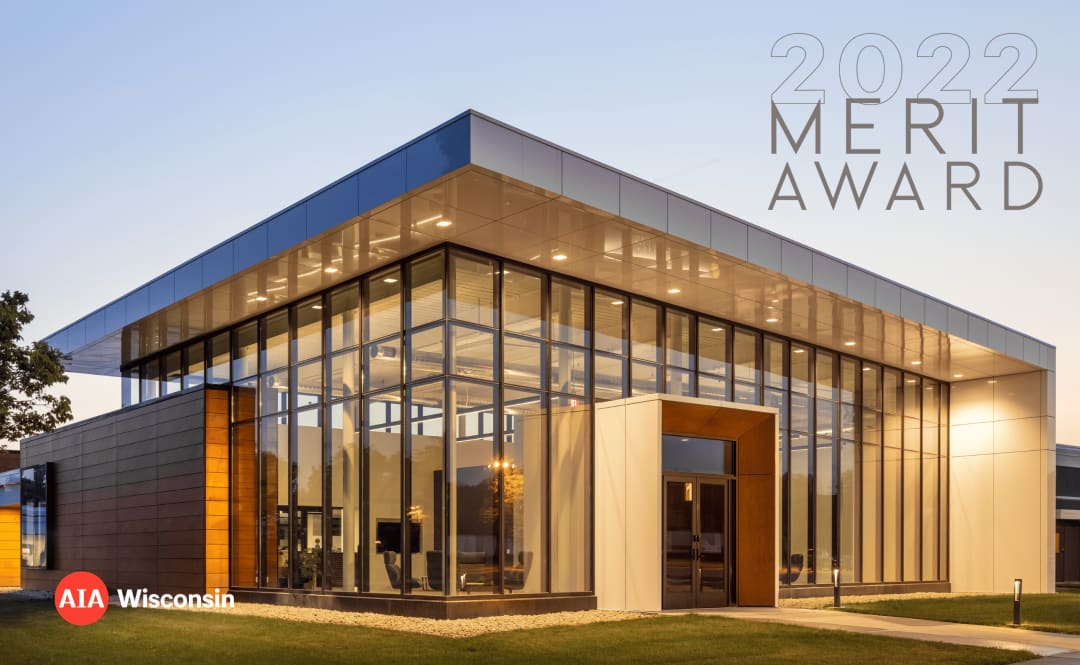
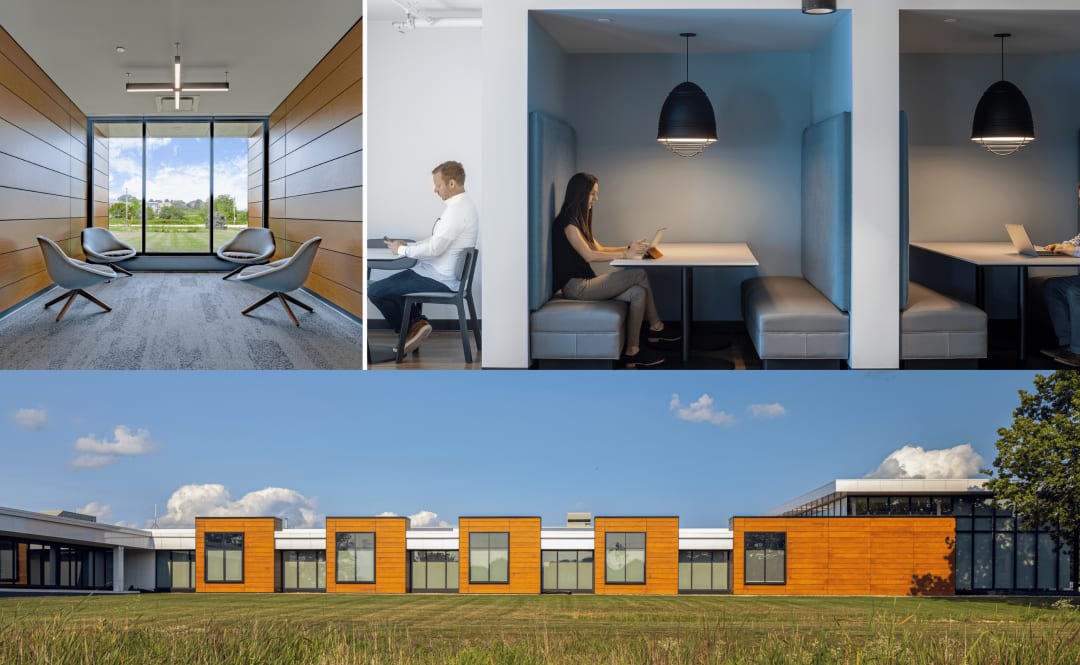
Received Merit Award for “Demonstrating the power of design in repositioning our corporate workplace”
Architecture Firm: OPN Architects
Owner: Springs Window Fashions
General Contractor: Ideal Builders
Project Description: A leader in window treatment design and manufacturing for 80 years, this window treatment manufacturer’s 1964-facility was outdated, undersized, and, ironically, lacked windows. An extensive renovation of both the interior and exterior of the corporate office included a conversion of 8,600 square feet of shop floor into a mix of open and private offices, new welcoming focal-point lobby, and a new training facility, breakroom, and fitness center. The most sustainable concept informing the design is perhaps the decision to renovate and reuse their existing facility. The decision to reuse rather than build new saved this project approximately 7-times the amount of embodied carbon. A new building envelope, all new mechanical and electrical systems and LED’s that operate in concert with available daylighting all work together to dramatically reduced operational carbon (energy use) by improving building performance.
Waunakee Public Library
(Waunakee, WI) – OPN Architects
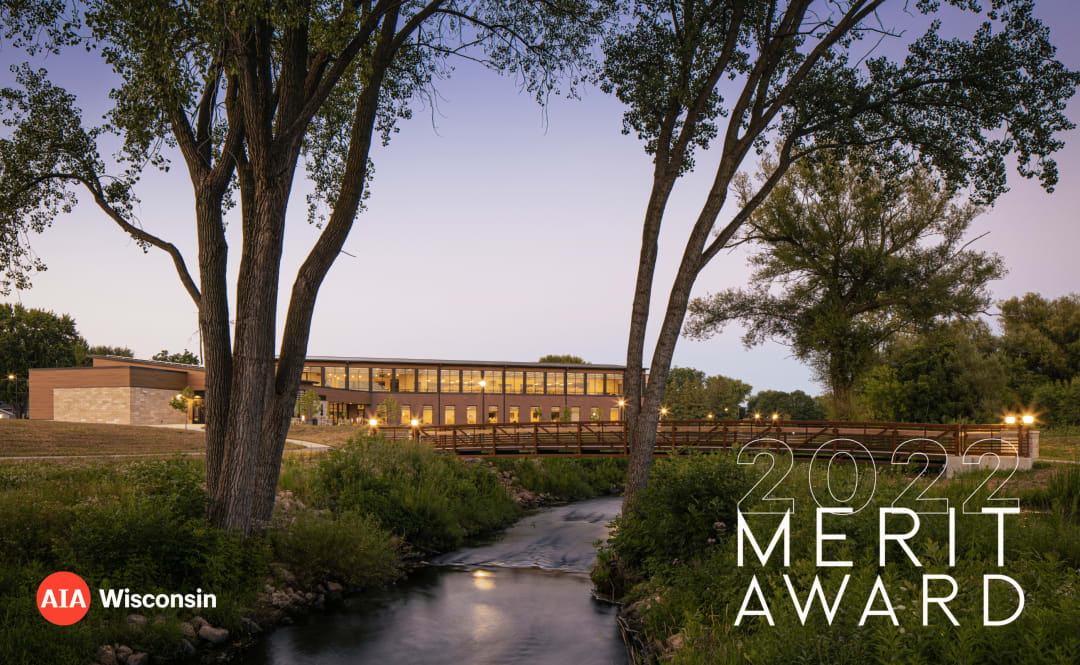
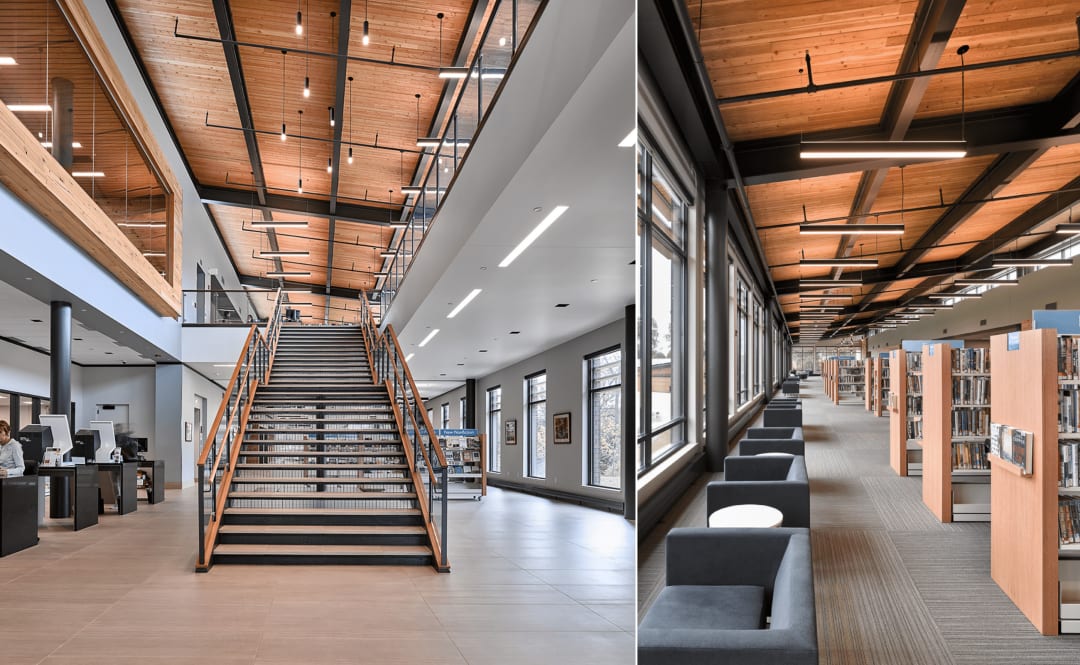
Received Merit Award for being a “Catalyst project for village economy and life”
Architecture Firm: OPN Architects
Owner: The Village of Waunakee
General Contractor: Vogel Bros. Building Co.
Project Description: This vibrant, multipurpose new 40,000 square foot public library serves as a space for the community to gather, collaborate, and celebrate through a design that embraces openness. Sited on an abandoned brownfield site, paralleling a creek and near the village’s downtown historic main street district, the building’s form creates a large public outdoor space between the building and the creek that can be used for recreation and public programming. Timeless brick and stone cladding respond to the materials used on nearby downtown properties, and green roof and a solar array set a standard for the village’s mission as environmental stewards. The building is Focus on Energy verified as an as-built energy use intensity (EUI), saving 42% as compared to a baseline model and resulting in an annual energy cost savings of over $28,000 for the city. The building also utilizes natural veneer stone quarried locally in Wisconsin, interior horizontal wood paneling from reclaimed lumber, and carpet tiles that are completely recycled.
Hamel Music Center
(Madison, WI) – Strang, Inc., Steinberg Hart
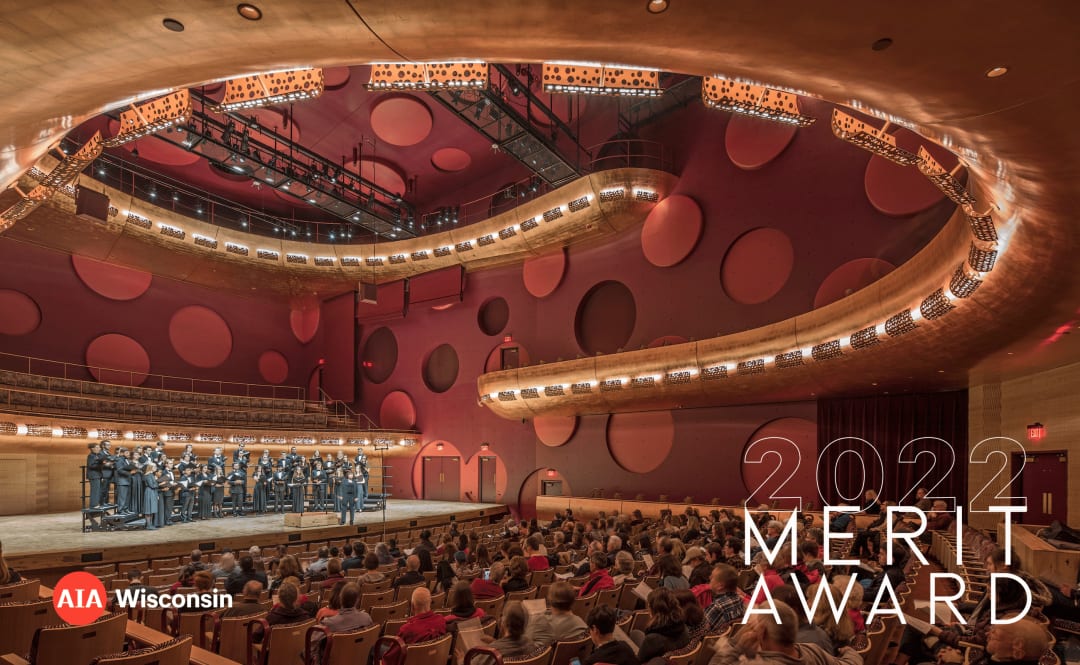
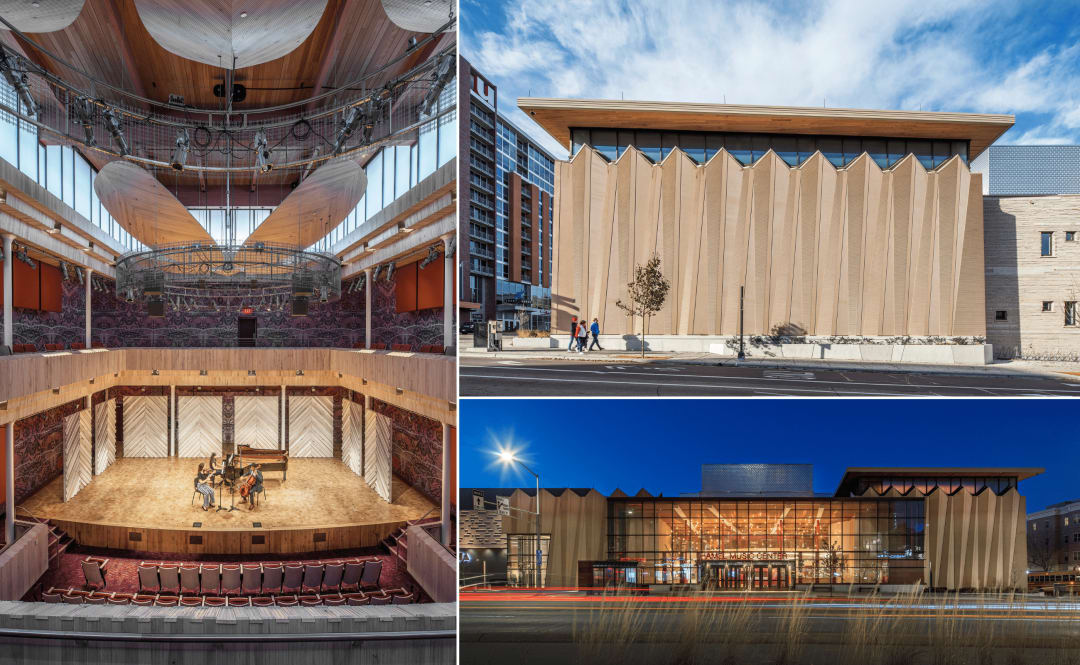
Received Merit Award for “Rich and playful design”
Design Architect: Malcolm Holzman, FAIA
Architecture Firm: Steinberg Hart, with Strang, Inc.
Owner: Wisconsin DFDM
General Contractor: JP Cullen
Project Description: Johann Wolfgang von Goethe wrote, “Architecture is frozen music.” The University of Wisconsin-Madison Hamel Music Center reveals folded, undulating forms of the precast panels that evoke this very imagery of flowing stage curtains frozen in time. Wisconsin’s landscapes inspire the interior scheme. Deep blues reflect the surrounding lakes, while the plum, gold, maroon, and copper colors used throughout the iconic performance spaces are the colors of the state tree, the sugar maple, in various stages of transformation. This culminates in the wallpaper that adorns the perimeter walls of the Recital Hall—inspired by local artist Bill Weege’s work, Like a Rolling Stone; the wallpaper is the artist’s largest installation in Madison. This project utilized an ample number of resources native to the Midwest region. Local timber and stone were able to greatly reduce the project’s overall carbon emissions, while the project’s exterior precast concrete cladding was fabricated locally and utilizes raw aggregate material sourced within the region.
Timber Lofts
(Milwaukee, WI) – Engberg Anderson Architects
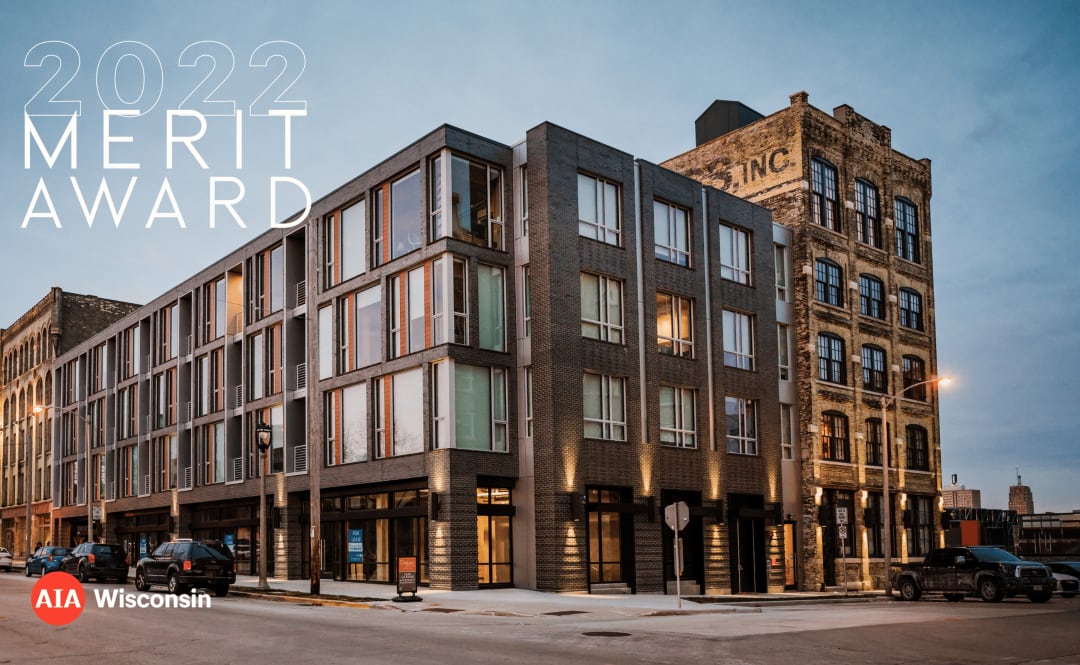
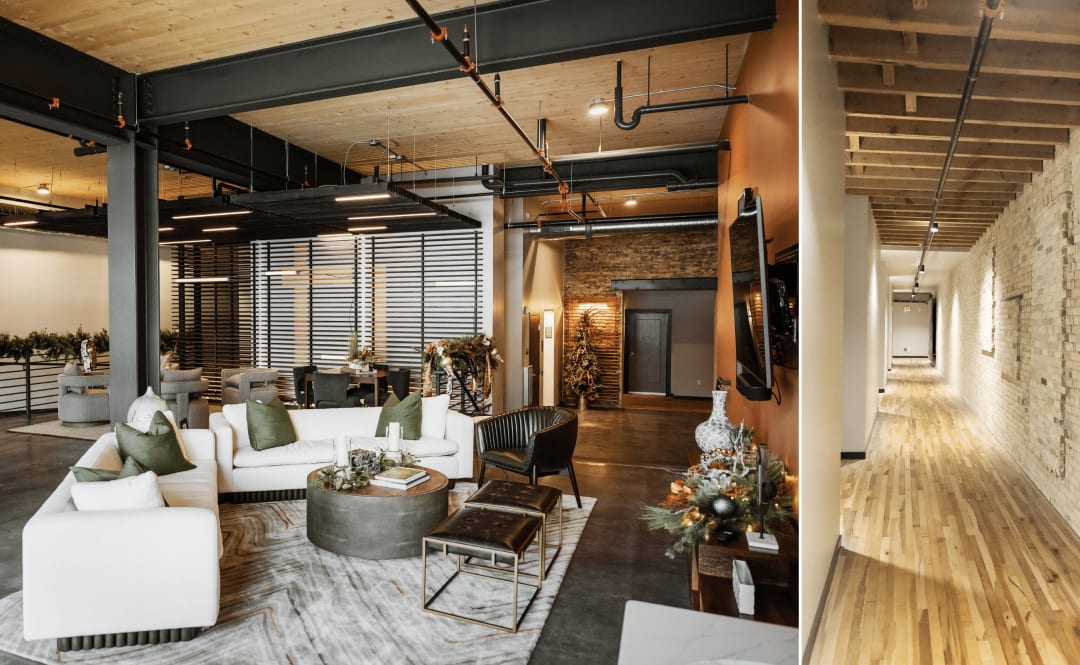
Received Merit award because the project “Demonstrates an innovative approach to preservation and sustainability, where new and old support each other”
Design Architect: Timothy M. Wolosz, AIA
Architecture Firm: Engberg Anderson Architects
Owner: Pieper Properties
General Contractor: Catalyst Construction
Project Description: Located in Milwaukee’s 5th Ward, Timber Lofts is a historic adaptation of the Louis Bass building into loft-like apartments. Keeping the 1800s aesthetic was important throughout the design process. To assist in the restoration, Historic Tax Credits were utilized so many design details, like window replacements, required National Park Service approval. The historic portion of the project includes residential units with heavy timber and cream city brick interior finishes. The addition to the south features CLT (Cross Laminated Timber) construction. CLT allows for exposed wood ceiling and floors that harmonize with the exposed wood of the existing building. The exterior retains the patina of the existing masonry, to inform the dark charcoal masonry of the new construction. Expressive detailing and large window elements complement the historic building and enhance the addition’s design.
Manitowish Waters Fire Hall
(Manitowish Waters, WI) – HGA Architects and Engineers
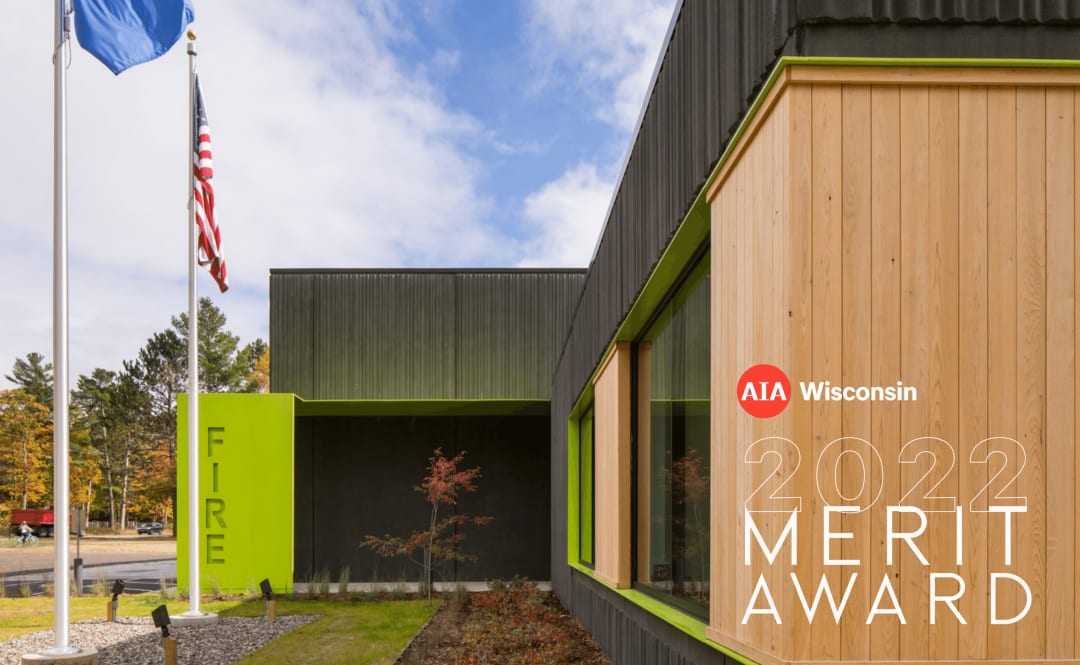
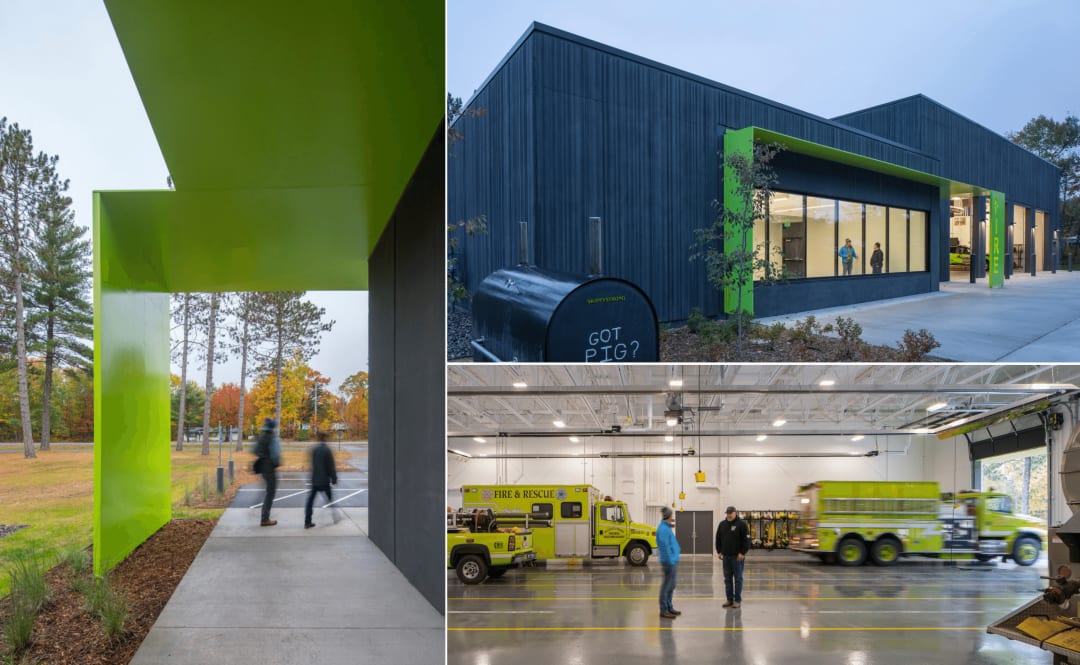
Received Merit Award because it “Did a lot with a little”
Design Architect: Josh Stowers, AIA
Architecture Firm: HGA Architects and Engineers
Owner: Manitowish Waters Fire Company
General Contractor: Market & Johnson
Project Description: The 10,300 square foot Manitowish Waters Fire Hall supports one of the last remaining volunteer fire companies in the state, providing its rural community with fire, rescue, and EMS services. This economical project replaces the town’s obsolete facility to support a nimble and wide-ranging emergency response, and to expand its use as a community hub. The pride the company takes in its equipment is reflected in its unique branding—high visibility safety green flames adorn the pump and ladder trucks, expressing the primary importance of the equipment to emergency response. The project site, formerly the location of a local bar, was able to eliminate additional site disturbance by taking advantage of the clearing created by the old building and parking lots, preserving existing trees and habitat throughout the site. Bird safety was considered by avoiding areas of corner glazing and ‘tunnel effect’ to reduce bird strike potential in the building.
The Bindery
(Bay View, WI) – Galbraith Carnahan Architects
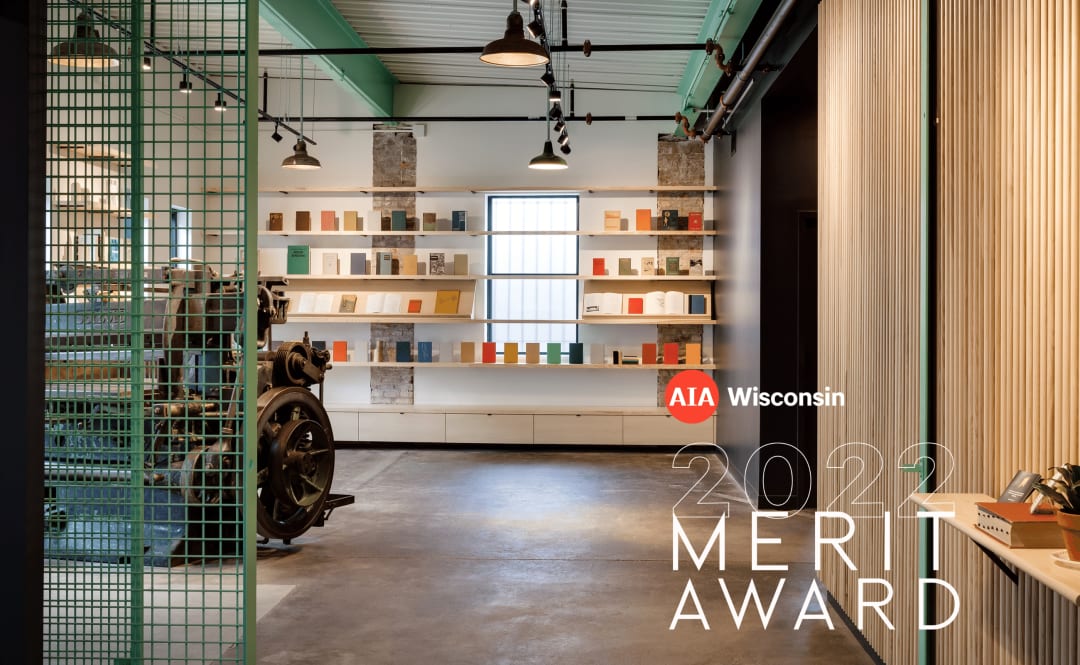
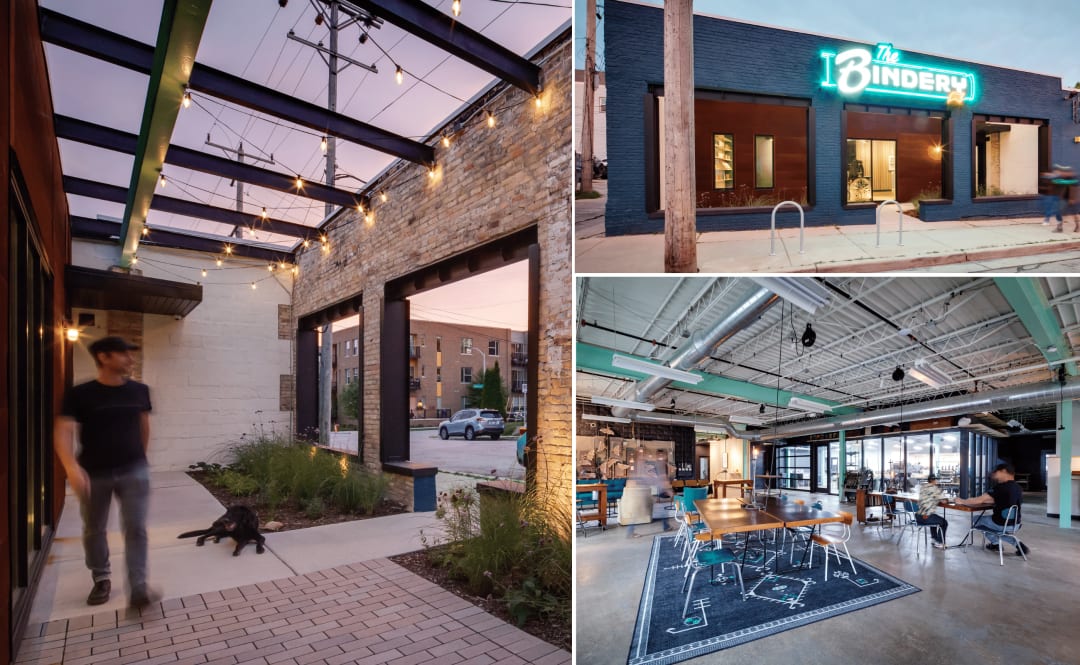
Received Merit Award because it “Created a home for the creative community of writers while maintaining the history and story.”
Design Architect: Nick Carnahan, AIA
Architecture Firm: Galbraith Carnahan Architects
Owner: The Bindery
General Contractor: JCP Construction
Project Description: Previously invisible to the undiscerning passerby, the windowless 1920’s building in Milwaukee’s Bay View neighborhood was home to a multi-generational family book bindery which closed operations in 2019. The new owner envisioned converting the city’s last traditional book bindery and its antique equipment into the city’s preeminent gathering place for Milwaukee’s writers, typographers, and print makers. The Bindery now includes a reimagined layout that visually connects a series of spaces of increasing privacy as you delve further into the building. These privacy gradients correspond to the different levels of membership at The Bindery as well as provide increased focus for members involved in highly concentrative tasks such as writing. A courtyard with more welcoming facade were added by removing a section of the original structure. The project served as a compelling example of how to transform an industrial asset into a cultural one that is deeply valued within the community.
BLOCK 27
(Sacramento, CA) – Johnsen Schmaling Architects
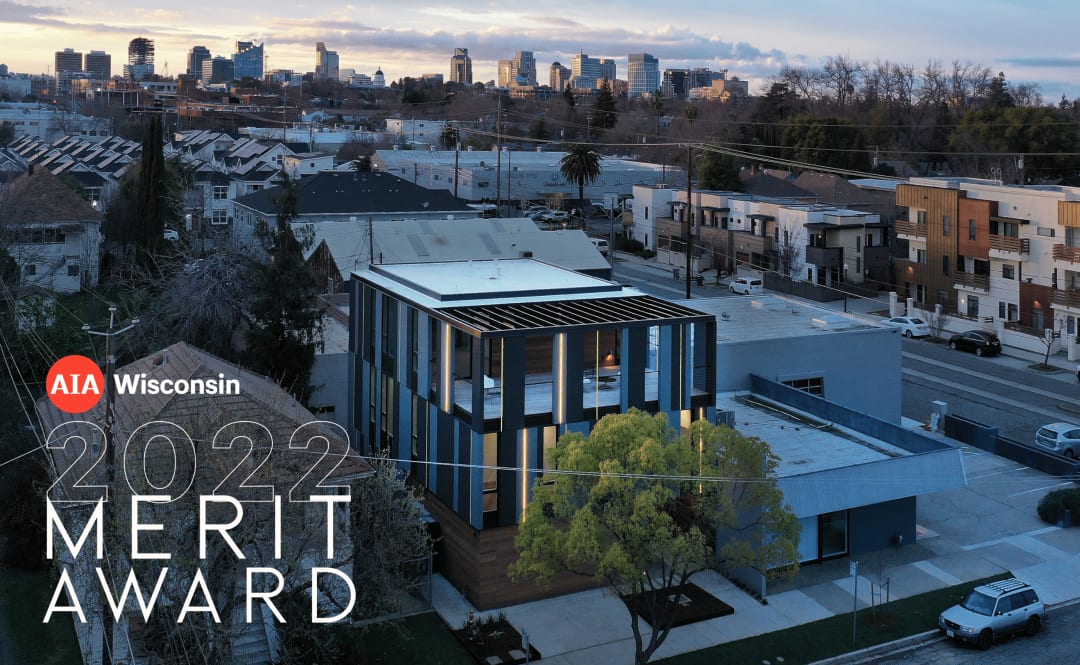
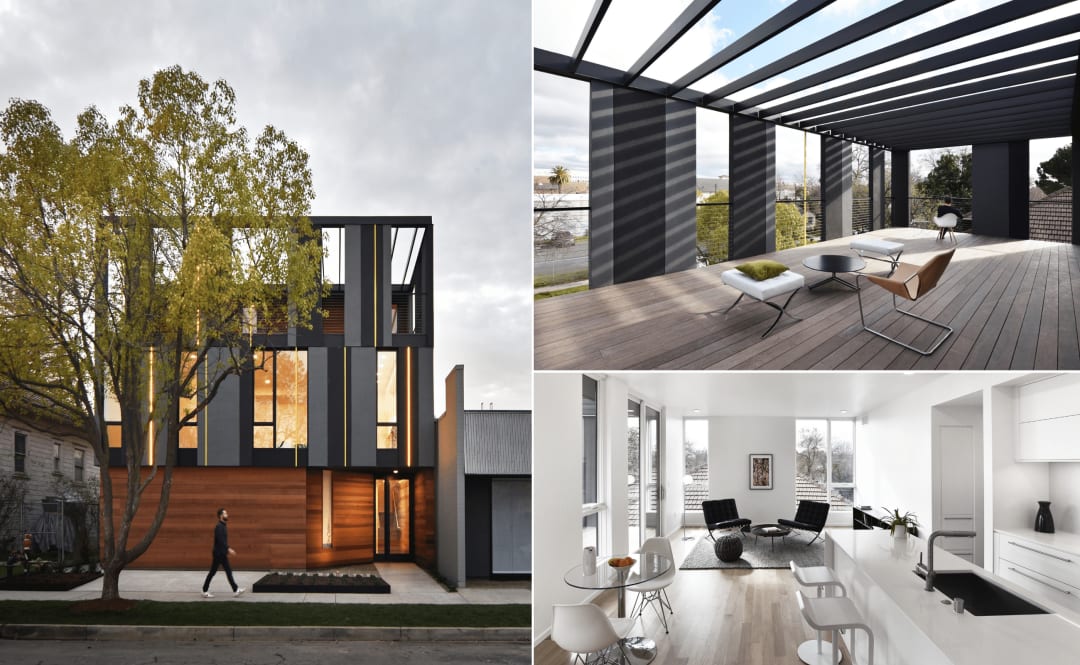
Received Merit award for “Interesting small lot, transient oriented infill protype”
Design Architects: Brian Johnsen, AIA & Sebastian Schmaling, AIA, LEED AP
Architecture Firm: Johnsen Schmaling Architects
Developer: Indie Capital
General Contractor: Indie Capital
Project Description: Block 27 is a small, four-unit rental apartment building in the Newton Booth district on Sacramento’s east side. The structure sits on an empty infill lot at the boundary between an area of distribution centers, warehouses, and light-industrial buildings on one side, and a dense residential neighborhood with treelined streets on the other. Taking its cues from its competing context, Block 27 was designed as a compact structure whose massing and façade articulation tempers its overall size and negotiates between the stark, monolithic warehouses and the homes/duplexes surrounding the site. Clearing the low-profile roofs of the adjacent commercial structures, the third-story roof terrace, a large outdoor room shared by all renters, takes advantage of undisturbed eastern views. The goal of the development team was to create an attractive housing option at the middle-to- lower end of the market.
2022 JURY

Mark Peters, AIA – Principal and founder of Studio Dwell Architects in Chicago, IL, a firm that specializes in unique, modern design. Peters’s professional career encompasses over 25 years of experience and 27+ award winning projects.
Kate Schwennsen, FAIA – Professor + Director Emeritus at Clemson University’s School of Architecture. Schwennsen was 2006 President of the American Institute of Architects (AIA), the second woman to serve as the elected leader of this then-149-year-old, 80,000-member organization. She is licensed to practice architecture in South Carolina.
Dr. Bruce Race, FAIA – Principal and founder of RACESTUDIO. His projects have received 33 design and planning awards including national awards from the American Institute of Architects, American Planning Association, Environmental Protection Agency and Society of College and University Planning. Dr. Race also serves as the Director of the Center for Sustainability and Resiliency (CeSAR) for the University of Houston’s Gerald D. Hines School of Architecture.
Come celebrate the 2022 Design Award winners at AIA Wisconsin’s annual Design Awards Gala. Tickets are now available. Event is open to the general public.
Become a Friend of Architecture!
Members of the public can support the future of architecture in Wisconsin by joining the Friends of Architecture. For a $75 donation each year, you will support scholarships and grants to architecture students and continuing education programs to Wisconsin architects. Friends of Architecture also receive AIA-member pricing at all public events, including the annual Design Awards Gala. Join today at FriendsofArchitecture.org.

